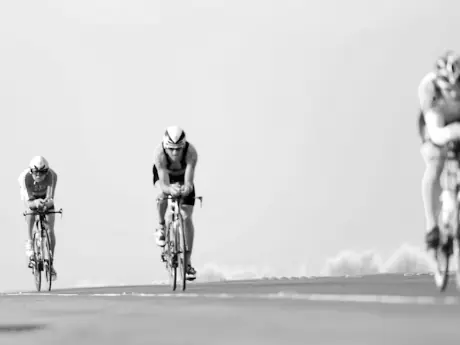
Aggressive positions on the bike can place a lot of stress on the joints of the spine. For triathletes spending huge amounts of time with their head back and chin low while riding in aerobars, pain in the cervical spine after a ride can become a big problem.
Your first step to solving neck pain should always be dialing in your position. Handlebar height and excessive reach are two elements of a bike fit that should be dealt with before you move on to anything else.
More: Seven Late-Season Half-Distance Triathlons
Once you've seen the experts and found a position that you're happy with, if your neck pain still lingers after a few hours on the bike, fear not. There are a few simple stretches and strengthening exercises you can do that will make holding up that bowling ball beneath your helmet a little bit easier.
Stretch
Tensing of the trapezius muscles that run along the side of the neck and shoulder that attach at the base of the head can become tense after long hours on the bike. Blood flow will be decreased, starving the muscles of needed oxygen. This can lead to trigger points, muscle spasms, and potentially quite a bit of pain.
To keep these muscles loose and relaxed (which is also important to do while you're riding) and to support the amount of time you're spending in the TT position, a consistent stretching routine is needed to stay pain free. These five exercises are a good place to start:
- Flexion: With your neck in a neutral posture, lower the chin toward the chest until you feel a stretch in the back of the neck. Hold for 20 to 30 seconds and repeat three times. Note that this is probably the same position you go to when you're neck starts to hurt on the bike, which points your aero helmet straight up in the air negating its advantages.
- Extension: With your shoulders completely relaxed (not tense as they sometimes become on the bike), tilt your head back (opposite of flexion) so that your nose is to the sky. You should feel a stretch in the back of the neck and in the muscles of the upper shoulder. Hold for 20 to 30 seconds and repeat three times.
- Right and Left Rotation: With your spine in a neutral position, rotate the head so that your chin touches your left shoulder. Hold for 20 to 30 seconds, then rotate your head so that your chin touches your right shoulder. Repeat three times in each direction.
- Right and Left Lateral Flexion: Starting with a neutral spine, bend the neck so that your left ear moves toward the left shoulder. Hold for 20 to 30 seconds. Go back to the starting position and repeat by moving your right ear toward your right shoulder. Repeat three times for each side.
- Chin Tucks: In a neutral spine position, place two fingers on the chin and guide the head back, away from the a forward head posture. The movement is very subtle. You should feel a stretch in the muscles of the upper neck and shoulder. Hold for five seconds and repeat 5 to 10 times.
Strengthening
Once your pain has subsided, strengthening the muscles that help to support the head will help you to prevent injuries or pain from popping down the road. Strengthening weak muscles will also help you to hold your TT position for longer amounts of time without fatiguing.
More: Goggles: History, Form and Function
Like all strengthening exercises, it will be easy to overdue it at first. Start slow and begin by doing these exercises no more than two to three times per week.
- Neck Sit-ups (extension and flexion): Lie down on your stomach on a flat and raised surface. Let your head hang off the edge in a flexed position. Raise the head past the neutral spine position and up into extension. Complete this movement slow and controlled, taking about five seconds to lift the head into extension. Repeat this movement for the flexors by lying on your back with your neck in extension. Bring the chin toward the chest. Start with one set of 10 repetitions in each position. Increase as necessary.
- Shoulder Rolls: This exercise is similar to a reverse shoulder shrug. In a neutral spine position, bring the shoulders up toward the ear (which will contract the upper traps). Keep your arms down by your side. Roll your shoulders back and down, stretching the same muscles you were just contracting. Be sure to rotate the shoulder blades together as you rotate back and down. Complete the circle until you reach the starting point. Start with one set of 10 repetitions and increase as necessary. You can also make this exercise more difficult by holding weights in each hand as you complete the movement.
Remember these exercises are not meant to be an alternative to seeing a doctor, as some injuries may be worse than others. As always, be smart, listen to your body, and consult a professional if your symptoms worsen.








Discuss This Article